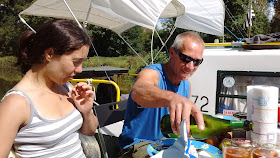I was contacted the other day by a guy in Wales who is about
to embark on the restoration of an old Westerly Nomad like mine. His mail
suggested that he knew what he was doing and why he was doing it. It also
suggested that he had given a great deal of thought to the project so I have
every confidence that he’ll do well. His note led me to consider why some
people restore boats and why other people should give serious though to it
before rushing out to buy the latest version from the jelly-mould. Here are a
few ideas I cam up with.
The green argument: building a boat requires a significant use of
resources. Why pollute the planet more by commissioning a new vessel when an
old boat (which has already made its footprint) can be recycled and restored?
Your restoration could give that old boat another twenty years of useful life –
beat the man, beat the consumerists, save the planet and enjoy!
A lack of choice among more modern boats: do you want a powerboat
which looks like it was pressed out of a jelly-mould, or a Bermudan sloop? That
seems to be the choice among production line boats. Demand something different
and you have to pay big money – look at the new or second-hand cost of a
Cornish Shrimper. Why pay more for a
‘look’ when the original vessel may be for sale in a creak somewhere near you.
Essentially, older boats offer a wider spectrum of choice.
The option of reconfiguring to suit your personal needs: Do you
really want four berths in the cabin or would two with an enlarged galley area
suit you better? If you renovate, the choice is yours. The guy I refer to above
is a single handed sailor. He doesn’t need four berths, but he does want an
enlarged galley with a decent sized cooker, sink and working area. Try finding
that option on a new boat!
The beauty and charm of a well cared for older boat: Old boats,
even GRP vessels, can be classic craft. The same attraction that turns heads
when a classic MGB roadster or an E Type Jaguar zips past, applies to boats.
Just like vintage cars, there is something very attractive about a well cared
for classic boat.
Deferring the cost: Buy a new boat or even a second hand one in
decent condition and you’ll be expected to pay for her immediately. Restore an
old boat and you spread the cost over a longer time-span, a pot of paint today
a hank of rope next month. The longer it takes to bring the boat back, the
longer you have to find the money.
Something about individuality: There is something special about a
sailor. The call of the sea is a call to freedom, self reliance and standing
away from the herd – and yet many of these individuals and freedom lovers drift
or charge around the coast in jelly moulds – mass produced, all looking pretty
similar. Take an old boat, renovate her, and you are sailing a classic. Yes she
may have been mass produced at one time – but in those days mass production was
defined in hundreds not thousands – and anyway there aren’t so many of them
left. Stamp your own personality on your renovation and you have an
individualist’s boat owned and sailed by an individualist. People will
understand and respect that – even if they can’t articulate it.
Finally What is the alternative?: Well, an unloved and old GRP boat
is broken up and scrapped. Not necessarily so bad – until you consider the
scrapping options – they are few and far between. For a start, you can’t burn
it. Burning GPR puts a huge and unacceptable volume of toxins into the air. You
could, of course cut it up and put it in landfill, but it will be there for
thousands of years. GRP isn’t exactly an inert material but it’s pretty close
to it.
So there you have it Seaward’s excuse for doing what he’s
doing. In truth, it’s satisfying occupation, a bit like gardening I suppose.
There is a pleasure to be taken from achieving results, especially when you can
sit back on a warm summer’s evening after a day’s work with a cold beer in your
hand. A time to dream of gentle breezes and think of the voyages to come.
Seaward
















